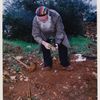
The first night of Hanukkah is tomorrow night, Dec. 8.
This is the first of two letters urging that to the traditional understandings of Hanukkah, we see it as the time for recommitment to protect, heal and rededicate the Temple of the Earth as anciently the Temple in Jerusalem was rededicated at this time of year.
In our second letter, we will suggest specific actions you can take on the eight days of Hanukkah, responding to the passionate message from the Breath that breathes all life: "For the eight days of Hanukkah, my True Love said to me: "Please save My Earth!"
At the Shalom Center website you will find an amazing illustration from the Middle Ages of the Green Menorah -- in one shape, a tree made up of branches and blossoms, and at the same time, a Tree made up of Light, as the Torah describes the Temple Menorah (Exodus 25:31-39).
And in tomorrow's letter, we are sharing another vision of the Green Menorah that sees it the same way. That one is from our own generation, created by the Shalom Center.
By fusing the tree and the menorah, the Green Menorah becomes the symbol of the intertwining of adamah (Earth) and adam (human earthlings).
It also symbolizes a Jewish commitment to renew the miracle of Hanukkah in our own generation: Using one day's oil to meet eight days' needs; doing our part so that by 2020, U.S. oil consumption is cut by seven-eighths.
In that way, in our own generation we can rededicate the universal Temple of Planet Earth, as the Talmud describes the rededication of the ancient Jewish Temple in Jerusalem. We can hold back the devastation that global scorching is already wreaking on our lives -- Hurricane Sandy, the devastating corn-country drought in the U.S., unheard-of floods in Vermont, not to mention disasters in Australia, Russia, Africa and Pakistan.
We invite you to join in this commitment to heal our planet and our human race from the climate crisis of global scorching.
- Hands-on action by congregations and congregants to reduce actual CO2 emissions on their own and to infuse their own celebrations of Jewish festivals, life-cycle events, prayers and education with eco-consciousness; and
- Advocacy for change in public policy, including such possibilities as transferring subsidies for Big Oil and Big coal to renewable energy development and placement; instituting a gradually rising carbon fee, with the proceeds divided three ways: preventing hardship from the higher cost of carbon products among the poor and working families; retraining workers (like coal miners) whose jobs are undermined by the shift away from carbon; and reducing the deficit.
To save our planet, crops, water supply and coastlines from the ravages of climate crisis and global scorching, the Shalom Center urges these seven directions of personal and policy change at all governmental levels, corporate and labor-union decisions, and household / congregational action. To work for these policy changes, write Office@theshalomcenter.org or the Shalom Center, 6711 Lincoln Drive, Philadelphia, PA 19119.
- Personal change: households set 5 percentof our annual coal, oil and gasoline costs as tzedakah ("charitable" contributions) to support sustainable-energy activism.
- Public policy: requiring energy producers to pay for the carbon emissions their products will cause, through a carbon tax, carbon caps or a combination.
- Personal change: For households, buying energy-conserving appliances, joining wind-energy plans, etc.
- Public policy: ending subsidies to such carbon-producing sources of energy as coal, oil and corn-based ethanol; constantly increasing subsidies for such non-carbon-emitting sources of energy as wind, solar, switch-grass.
- Personal change: Greening our own new homes and congregations and retrogreening our present buildings.
- Public policy: enacting strong building-code regulations for new buildings and for retrogreening old ones.
- Personal change: As households and congregations, car-pooling, walking or biking to congregations, jobs, etc.
- Public policy: ending subsidies to conventional autos, highways and airplanes; strictly limiting emissions from autos and airplanes; raising subsidies to bikes, rail, walking and to holding long-distance meetings by teleconference.
- Personal change: choices of urban-style high-density living (whether in actual cities or in suburbs)
- Policy: subsidize and invest in urban recreation, workplaces, etc. vs. sprawl and low-density housing.
- In Jewish life, infusing festivals, life-cycle markers (especially intergenerational markers like bar/bat mitzvah a d confirmation), prayer and Torah study with concern for the earth and climate.
- In public policy, subsidizing scientific climate-crisis analysis; climate-centered educational projects throughout school years from pre-K through grad school; support for art, literature, music, dance, film, games, etc. that address climate crisis.
- In our individual and congregational practice, strongly encouraging -- even more than before -- setting aside restful time and making minimal use of carbon-emitting energy for the time of Shabbat itself, as a wise and sacred Jewish practice.
- In public policy, requiring paid leave and holiday time for parental care and neighborhood-centered celebration.
And we attThe Shalom Center hope you can also give a Hanukkah gift to our work, a gift to help us keep on teaching and acting to heal and save our planet. To give that sacred gift, please click on the "Donate" line on our home page at http://www.theshalomcenter.org
Thanks!
Tomorrow: practical actions we can take on each of the days of Hanukkah. Small enough to do, big enough to matter.
Shalom, salaam, paz, peace!
